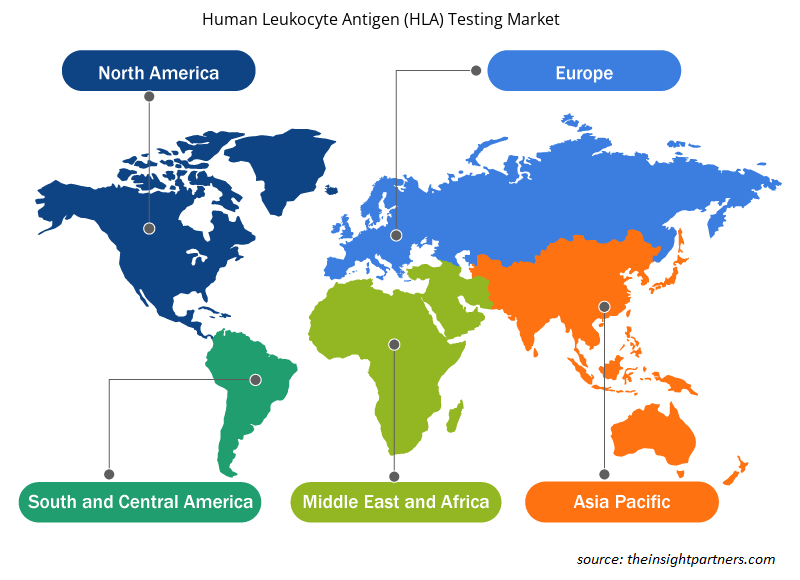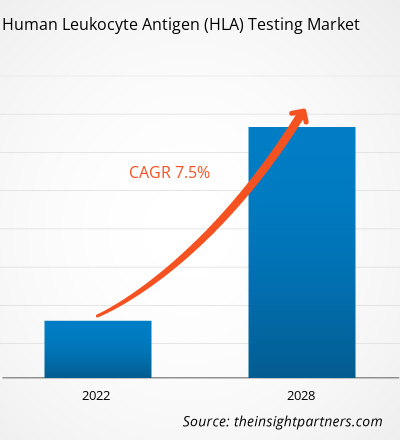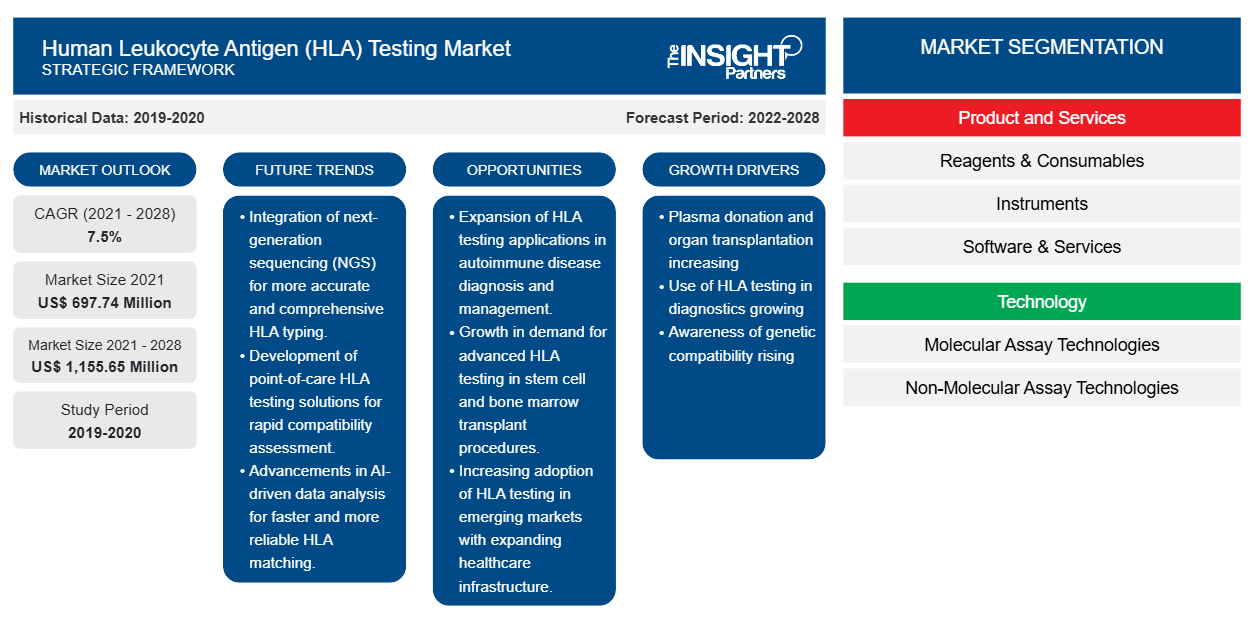Se proyecta que el mercado de pruebas de antígeno leucocitario humano (HLA) alcance los US$ 1.155,65 millones para 2028 desde los US$ 697,74 millones en 2021; se espera que registre una CAGR del 7,5% entre 2022 y 2028.
Los antígenos leucocitarios humanos desempeñan un papel esencial en la respuesta inmunitaria del organismo a las sustancias externas. El principal uso de las pruebas de HLA es emparejar a los receptores de trasplantes de órganos y tejidos con donantes compatibles. Las pruebas de HLA también implican la detección de anticuerpos en los receptores de trasplantes que podrían atacar el tejido u órgano donado como parte de una respuesta inmunitaria.
El informe ofrece información y un análisis profundo del mercado de pruebas de antígeno leucocitario humano (HLA), haciendo hincapié en las tendencias del mercado, los avances tecnológicos y la dinámica del mercado, entre otros. También proporciona el análisis del panorama competitivo de los principales actores del mercado a nivel mundial. Además, incluye el impacto de la pandemia de COVID-19 en el mercado en todas las regiones principales. La pandemia de COVID-19 creó una crisis de salud pública y una crisis económica en todo el mundo. Antes de la pandemia, el mercado de pruebas de antígeno leucocitario humano (HLA) estaba creciendo continuamente debido a la regularidad en la evaluación de los donantes de órganos, los consuelos y los tratamientos. La primera ola de COVID-19 interrumpió las consultas, los seguimientos y las pruebas de detección relacionadas con enfermedades distintas de COVID-19. Varias empresas experimentaron graves pérdidas en el último trimestre de 2019; la pandemia tuvo particularmente efectos adversos en el mercado global en el primer y segundo trimestre de 2020. Las empresas de todo el mundo se vieron obstaculizadas debido a la interrupción de las cadenas de suministro y al aumento de la demanda de productos y servicios sanitarios. Para reducir la infección por COVID-19 en hospitales y clínicas, los profesionales de la salud y los pacientes adoptaron y prefirieron tratar a sus pacientes de forma remota. Estas circunstancias imprevisibles también obstaculizaron los procedimientos de trasplante de órganos. Muchos tratamientos quirúrgicos y consultas no urgentes se cancelaron o pospusieron, y las cirugías electivas se suspendieron en muchas instituciones para limitar la propagación del SARS-CoV-2, así como para reservar y reasignar recursos, incluido el personal de atención médica (enfermeras y anestesiólogos), el equipo médico (equipo de protección personal y respiradores) y las camas. La recomendación de "quedarse en casa" resultó en una reducción significativa en las cirugías de donación y trasplante de órganos. Estas condiciones frenaron el crecimiento del mercado de pruebas de antígeno leucocitario humano (HLA) en todo el mundo en 2020.
Personalice este informe según sus necesidades
Obtendrá personalización en cualquier informe, sin cargo, incluidas partes de este informe o análisis a nivel de país, paquete de datos de Excel, así como también grandes ofertas y descuentos para empresas emergentes y universidades.
- Obtenga las principales tendencias clave del mercado de este informe.Esta muestra GRATUITA incluirá análisis de datos, desde tendencias del mercado hasta estimaciones y pronósticos.
Perspectivas del mercado
El aumento del número de procedimientos de donación de plasma y trasplante de órganos impulsa el crecimiento del mercado
Los antígenos leucocitarios humanos (HLA) son proteínas especializadas presentes en todas las superficies celulares del cuerpo humano, excepto los glóbulos rojos. Las pruebas de HLA tienen una aplicación significativa en el trasplante de órganos , que puede recomendarse como parte del tratamiento de la insuficiencia renal, la cirrosis hepática crónica y la enfermedad cardíaca crónica, entre otros problemas médicos. La creciente prevalencia de enfermedades crónicas e insuficiencia orgánica conduce a una gran demanda de procedimientos de trasplante de órganos, así como de pruebas de HLA. Antes del trasplante, se realizan pruebas de HLA para verificar la compatibilidad de tejidos entre pacientes y donantes para evitar el rechazo del injerto. En los últimos años, el trasplante se ha convertido en una práctica exitosa en todo el mundo. Según los datos publicados en el Observatorio Global sobre Donación y Trasplante (GODT), en 2020, se registraron 129.681 trasplantes de órganos en total. De estos, el 31,7% fueron trasplantes de riñón vivo y el 20,40% fueron trasplantes de hígado vivo.
Los gobiernos de varios países están tomando iniciativas para difundir la conciencia sobre la necesidad de la donación de órganos y los beneficios del trasplante de órganos en ciertos procedimientos de tratamiento. Por ejemplo, la Red de Obtención y Trasplante de Órganos (OPTN, por sus siglas en inglés) ha implementado algunas estrategias para mejorar el número de procedimientos de trasplante de órganos en los EE. UU. Estas estrategias se centran en aumentar el número de trasplantes de órganos y tejidos entre pacientes con enfermedades orgánicas en etapa terminal, alterar la distribución actual de órganos y modificar la lista de espera de trasplantes de órganos redistribuyendo la lista de espera de órganos existente. Además, la OPTN ha utilizado estrategias innovadoras para mejorar el trasplante de órganos. Estas estrategias innovadoras incluyen el uso optimizado de órganos obtenidos de pacientes fallecidos [por ejemplo, donación después de muerte cardíaca (DCD, por sus siglas en inglés) o donantes con muerte cerebral], reducir los descartes de órganos, promover la donación en vida y mejorar la tasa de autorización de donación potencial de órganos.
Por lo tanto, la creciente demanda de trasplantes de órganos conduce a la necesidad de un número mayor de kits y consumibles para pruebas de HLA, lo que impulsa el crecimiento del mercado de pruebas de HLA.
Información basada en productos y servicios
Según los productos y servicios, el mercado de pruebas de antígeno leucocitario humano (HLA) se segmenta en reactivos y consumibles, instrumentos, software y servicios. En 2021, el segmento de reactivos y consumibles tuvo la mayor participación del mercado y se espera que registre la CAGR más rápida del 7,5 % durante el período de pronóstico. HLA) testing market is segmented into reagents and consumables, instruments, and software and services. In 2021, the reagents and consumables segment held the largest share of the market, and it is expected to register the fastest CAGR of 7.5% during the forecast period.
Perspectivas basadas en la tecnología
Según la tecnología, el mercado de pruebas de antígeno leucocitario humano (HLA) se segmenta en tecnologías de análisis molecular y tecnologías de análisis no molecular. En 2021, el segmento de tecnologías de análisis molecular tuvo la mayor participación del mercado y se espera que registre una CAGR más alta del 7,7 % durante 2022-2028.HLA) testing market is segmented into molecular assay technologies and non-molecular assay technologies. In 2021, the molecular assay technologies segment held a largest share of the market, and it is expected to record a higher CAGR of 7.7% during 2022–2028.
Información basada en el usuario final
Según el usuario final, el mercado de pruebas de antígeno leucocitario humano (HLA) está segmentado en laboratorios de referencia independientes, hospitales y centros de trasplantes, entre otros. En 2021, el segmento de laboratorios de referencia independientes tuvo la mayor participación del mercado. Sin embargo, se espera que el segmento de hospitales y centros de trasplantes registre la CAGR más alta del 7,9 % durante 2022-2028HLA) testing market is segmented into independent reference laboratories, hospitals and transplant centers, and others. In 2021, the independent reference laboratories segment held the largest share of the market. However, hospitals and transplant centers segment is expected to report the highest CAGR of 7.9% during 2022–2028
Los actores del mercado de pruebas de antígeno leucocitario humano (HLA) adoptan estrategias orgánicas como el lanzamiento y la expansión de productos para expandir su presencia y cartera de productos en todo el mundo, además de satisfacer las crecientes demandas de productos.HLA) testing market players adopt organic strategies such as product launch and expansion to expand their footprint and product portfolio worldwide, along with meeting the growing product demands.
Por geografía
Según la geografía, el mercado de pruebas de antígeno leucocitario humano (HLA) está segmentado en América del Norte (EE. UU., Canadá y México), Europa (Reino Unido, Alemania, Francia, Italia, España y el resto de Europa), Asia Pacífico (China, Japón, India, Australia, Corea del Sur y el resto de Asia Pacífico), Medio Oriente y África (EAU, Arabia Saudita, Sudáfrica y el resto de Medio Oriente y África) y América del Sur y Central (Brasil, Argentina y el resto de América del Sur y Central).
Prueba de antígeno leucocitario humano
Perspectivas regionales del mercado de pruebas de antígeno leucocitario humano (HLA)
Los analistas de Insight Partners explicaron en detalle las tendencias y los factores regionales que influyen en el mercado de pruebas de antígeno leucocitario humano (HLA) durante el período de pronóstico. Esta sección también analiza los segmentos y la geografía del mercado de pruebas de antígeno leucocitario humano (HLA) en América del Norte, Europa, Asia Pacífico, Oriente Medio y África, y América del Sur y Central.

- Obtenga datos regionales específicos para el mercado de pruebas de antígeno leucocitario humano (HLA)
Alcance del informe de mercado de pruebas de antígeno leucocitario humano (HLA)
| Atributo del informe | Detalles |
|---|---|
| Tamaño del mercado en 2021 | US$ 697,74 millones |
| Tamaño del mercado en 2028 | US$ 1.155,65 millones |
| CAGR global (2021-2028) | 7,5% |
| Datos históricos | 2019-2020 |
| Período de pronóstico | 2022-2028 |
| Segmentos cubiertos | Por productos y servicios
|
| Regiones y países cubiertos | América del norte
|
| Líderes del mercado y perfiles de empresas clave |
|
Densidad de actores del mercado de pruebas de antígeno leucocitario humano (HLA): comprensión de su impacto en la dinámica empresarial
El mercado de pruebas de antígeno leucocitario humano (HLA) está creciendo rápidamente, impulsado por la creciente demanda de los usuarios finales debido a factores como la evolución de las preferencias de los consumidores, los avances tecnológicos y una mayor conciencia de los beneficios del producto. A medida que aumenta la demanda, las empresas amplían sus ofertas, innovan para satisfacer las necesidades de los consumidores y aprovechan las tendencias emergentes, lo que impulsa aún más el crecimiento del mercado.
La densidad de actores del mercado se refiere a la distribución de las empresas o firmas que operan dentro de un mercado o industria en particular. Indica cuántos competidores (actores del mercado) están presentes en un espacio de mercado determinado en relación con su tamaño o valor total de mercado.
Las principales empresas que operan en el mercado de pruebas de antígeno leucocitario humano (HLA) son:
- Termo Fisher Scientific Inc.
- CuidadoDx
- Qiagen
- Ilumina Inc.
- Laboratorios Bio-Rad, Inc.
Descargo de responsabilidad : Las empresas enumeradas anteriormente no están clasificadas en ningún orden particular.

- Obtenga una descripción general de los principales actores clave del mercado de pruebas de antígeno leucocitario humano (HLA)
Perfiles de empresas
- Termo Fisher Scientific Inc.
- CuidadoDx
- Qiagen
- Ilumina Inc.
- Laboratorios Bio-Rad, Inc.
- TBG Diagnostics Limited
- F.Hoffmann-La Roche Ltd.
- Producto Bio de Takara Inc.
- Corporación Luminex
- Omixon Inc.
- El centro de secuenciación
- Protrans
- Compañía HistoGenetics LLC.
- Genómica de CD
- Biociencias de Qunitara
- CeGat GmbH
- Biolabs Creativos Inc.
- Análisis histórico (2 años), año base, pronóstico (7 años) con CAGR
- Análisis PEST y FODA
- Tamaño del mercado, valor/volumen: global, regional y nacional
- Industria y panorama competitivo
- Conjunto de datos de Excel
Informes recientes
Testimonios
Razón para comprar
- Toma de decisiones informada
- Comprensión de la dinámica del mercado
- Análisis competitivo
- Información sobre clientes
- Pronósticos del mercado
- Mitigación de riesgos
- Planificación estratégica
- Justificación de la inversión
- Identificación de mercados emergentes
- Mejora de las estrategias de marketing
- Impulso de la eficiencia operativa
- Alineación con las tendencias regulatorias























 Obtenga una muestra gratuita para - Mercado de pruebas de antígeno leucocitario humano (HLA)
Obtenga una muestra gratuita para - Mercado de pruebas de antígeno leucocitario humano (HLA)